The Cambridge History of Japan, Vol. 4: Early Modern Japan
Подождите немного. Документ загружается.

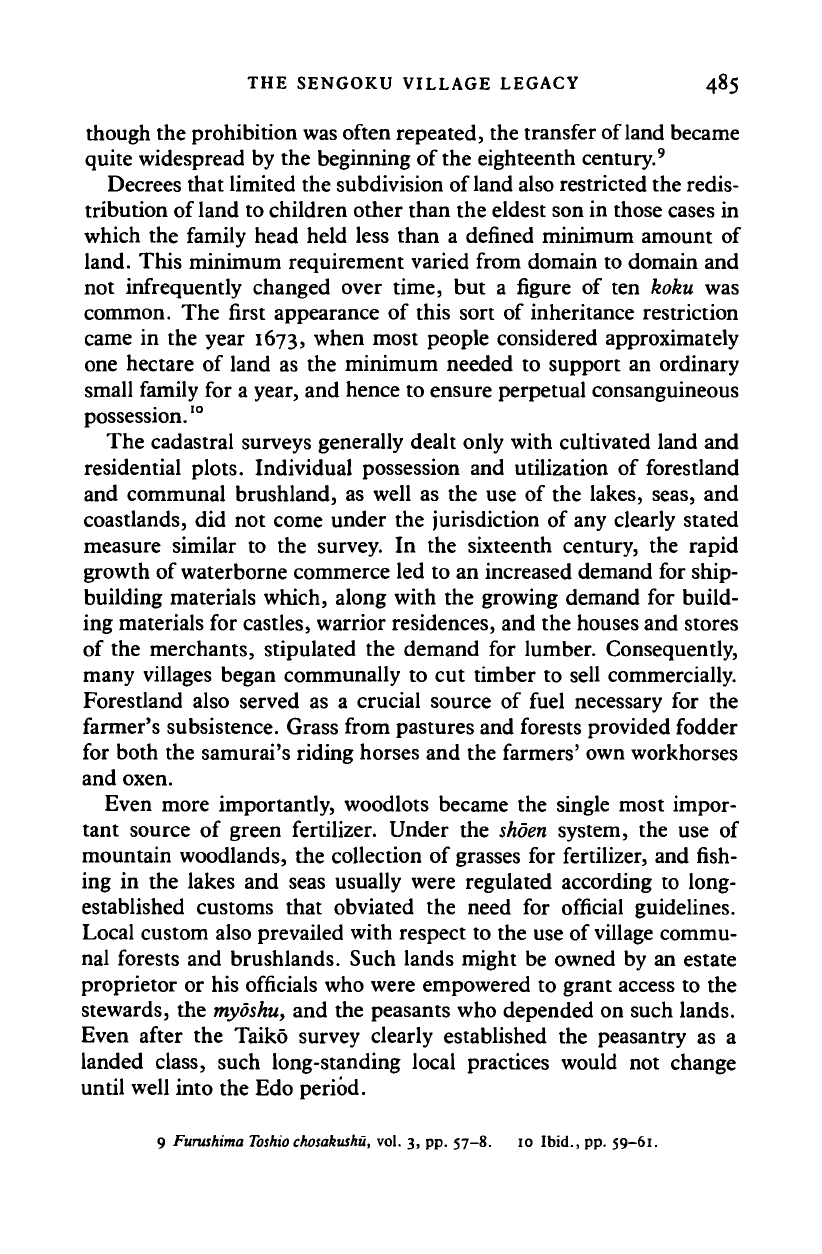
THE SENGOKU VILLAGE LEGACY 485
though the prohibition was often repeated, the transfer of land became
quite widespread by the beginning of the eighteenth century.
9
Decrees that limited the subdivision of land also restricted the redis-
tribution of land to children other than the eldest son in those cases in
which the family head held less than a defined minimum amount of
land. This minimum requirement varied from domain to domain and
not infrequently changed over time, but a figure of ten koku was
common. The first appearance of this sort of inheritance restriction
came in the year 1673, when most people considered approximately
one hectare of land as the minimum needed to support an ordinary
small family for a year, and hence to ensure perpetual consanguineous
possession.
10
The cadastral surveys generally dealt only with cultivated land and
residential plots. Individual possession and utilization of forestland
and communal brushland, as well as the use of the lakes, seas, and
coastlands, did not come under the jurisdiction of any clearly stated
measure similar to the survey. In the sixteenth century, the rapid
growth of waterborne commerce led to an increased demand for ship-
building materials which, along with the growing demand for build-
ing materials for castles, warrior residences, and the houses and stores
of the merchants, stipulated the demand for lumber. Consequently,
many villages began communally to cut timber to sell commercially.
Forestland also served as a crucial source of fuel necessary for the
farmer's subsistence. Grass from pastures and forests provided fodder
for both the samurai's riding horses and the farmers' own workhorses
and oxen.
Even more importantly, woodlots became the single most impor-
tant source of green fertilizer. Under the
shoen
system, the use of
mountain woodlands, the collection of grasses for fertilizer, and fish-
ing in the lakes and seas usually were regulated according to long-
established customs that obviated the need for official guidelines.
Local custom also prevailed with respect to the use of village commu-
nal forests and brushlands. Such lands might be owned by an estate
proprietor or his officials who were empowered to grant access to the
stewards, the
myoshu,
and the peasants who depended on such lands.
Even after the Taiko survey clearly established the peasantry as a
landed class, such long-standing local practices would not change
until well into the Edo period.
9 Furushima
Toshio
chosakushu,
vol. 3, pp. 57-8. 10 Ibid., pp.
59-61.
Cambridge Histories Online © Cambridge University Press, 2008
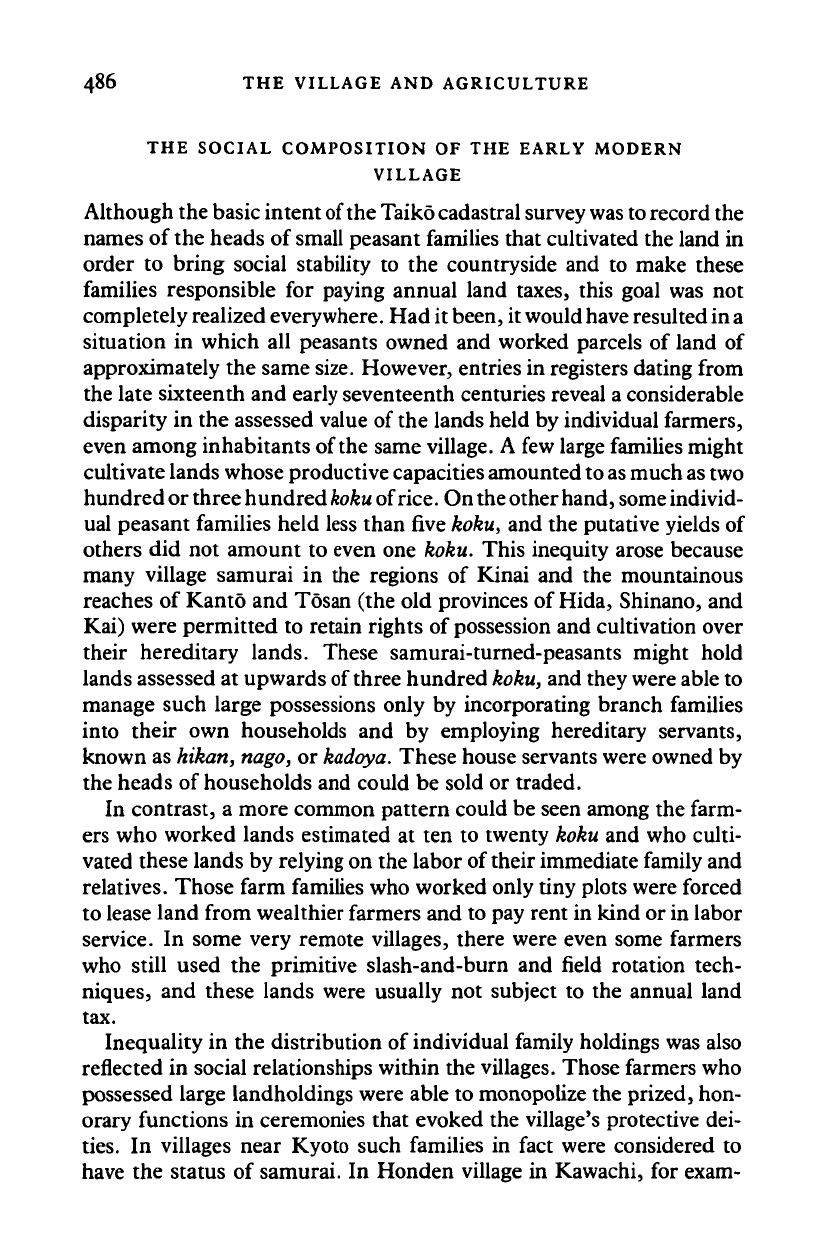
486 THE VILLAGE AND AGRICULTURE
THE SOCIAL COMPOSITION OF THE EARLY MODERN
VILLAGE
Although the basic intent of the Taiko cadastral survey
was to
record the
names of the heads of
small
peasant families that cultivated the land in
order to bring social stability to the countryside and to make these
families responsible for paying annual land taxes, this goal was not
completely realized
everywhere.
Had it been, it would
have
resulted in
a
situation in which all peasants owned and worked parcels of land of
approximately the same
size.
However, entries in registers dating from
the late sixteenth and early seventeenth centuries reveal a considerable
disparity in the assessed value of the lands held by individual farmers,
even among inhabitants of the same village. A few large families might
cultivate lands whose productive capacities amounted
to as
much
as
two
hundred or three hundred
koku
of
rice.
On the other hand,
some
individ-
ual peasant families held less than five koku, and the putative yields of
others did not amount to even one koku. This inequity arose because
many village samurai in the regions of Kinai and the mountainous
reaches of Kanto and Tosan (the old provinces of Hida, Shinano, and
Kai) were permitted to retain rights of possession and cultivation over
their hereditary lands. These samurai-turned-peasants might hold
lands assessed at upwards of three hundred
koku,
and they were able to
manage such large possessions only by incorporating branch families
into their own households and by employing hereditary servants,
known as hikan,
nago,
or
kadoya.
These house servants were owned by
the heads of households and could be sold or traded.
In contrast, a more common pattern could be seen among the farm-
ers who worked lands estimated at ten to twenty koku and who culti-
vated these lands by relying on the labor of their immediate family and
relatives. Those farm families who worked only tiny plots were forced
to lease land from wealthier farmers and to pay rent in kind or in labor
service. In some very remote villages, there were even some farmers
who still used the primitive slash-and-burn and field rotation tech-
niques, and these lands were usually not subject to the annual land
tax.
Inequality in the distribution of individual family holdings was also
reflected in social relationships within the villages. Those farmers who
possessed large landholdings were able to monopolize the prized, hon-
orary functions in ceremonies that evoked the village's protective dei-
ties.
In villages near Kyoto such families in fact were considered to
have the status of samurai. In Honden village in Kawachi, for exam-
Cambridge Histories Online © Cambridge University Press, 2008
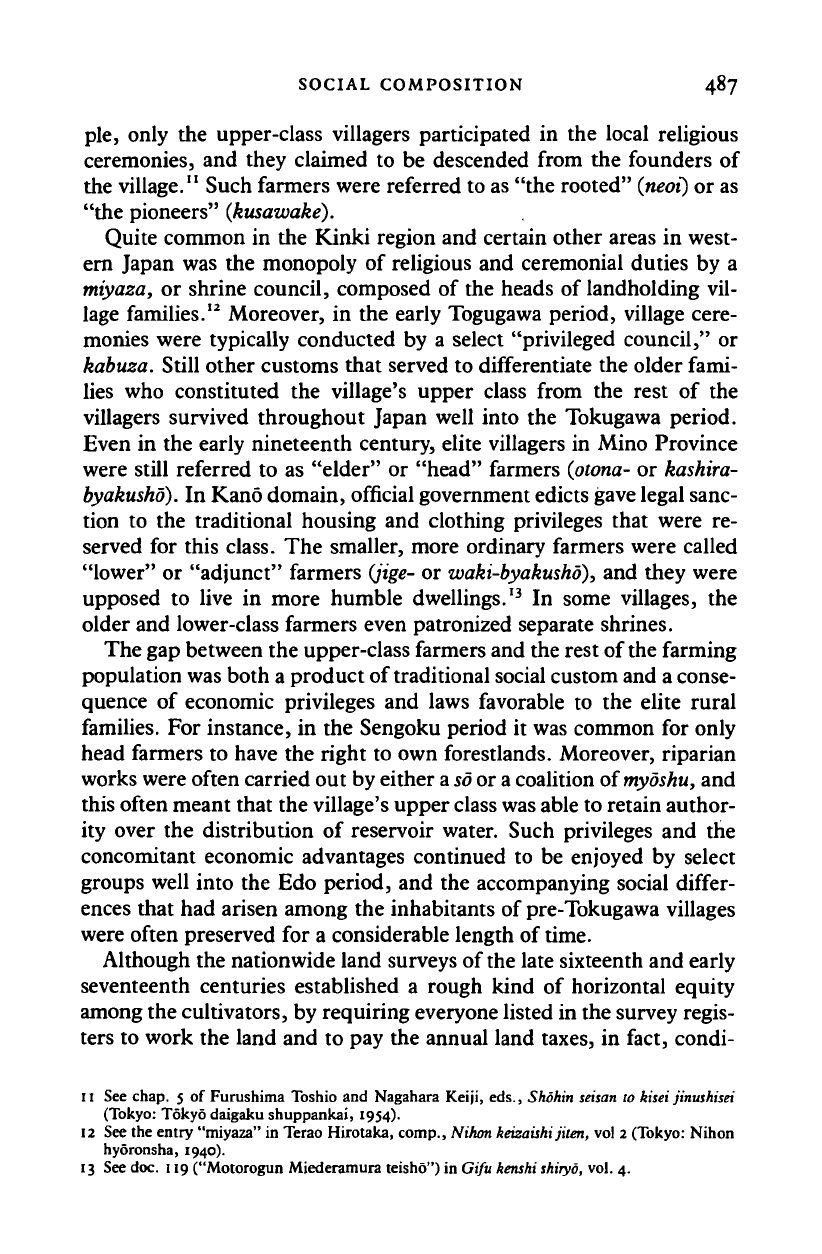
SOCIAL COMPOSITION 487
pie,
only the upper-class villagers participated in the local religious
ceremonies, and they claimed to be descended from the founders of
the village." Such farmers were referred to as "the rooted"
(neoi)
or as
"the pioneers" (kusawake).
Quite common in the Kinki region and certain other areas in west-
ern Japan was the monopoly of religious and ceremonial duties by a
miyaza, or shrine council, composed of the heads of landholding vil-
lage families.
12
Moreover, in the early Togugawa period, village cere-
monies were typically conducted by a select "privileged council," or
kabuza. Still other customs that served to differentiate the older fami-
lies who constituted the village's upper class from the rest of the
villagers survived throughout Japan well into the Tokugawa period.
Even in the early nineteenth century, elite villagers in Mino Province
were still referred to as "elder" or "head" farmers
(otona-
or
kashira-
byakusho).
In Kano domain, official government edicts gave legal sanc-
tion to the traditional housing and clothing privileges that were re-
served for this class. The smaller, more ordinary farmers were called
"lower" or "adjunct" farmers
(jige-
or
waki-byakusho),
and they were
upposed to live in more humble dwellings.
13
In some villages, the
older and lower-class farmers even patronized separate shrines.
The gap between the upper-class farmers and the rest of the farming
population was both a product of traditional social custom and a conse-
quence of economic privileges and laws favorable to the elite rural
families. For instance, in the Sengoku period it was common for only
head farmers to have the right to own forestlands. Moreover, riparian
works were often carried out by either
a so
or
a
coalition of
myoshu,
and
this often meant that the village's upper class was able to retain author-
ity over the distribution of reservoir water. Such privileges and the
concomitant economic advantages continued to be enjoyed by select
groups well into the Edo period, and the accompanying social differ-
ences that had arisen among the inhabitants of pre-Tokugawa villages
were often preserved for a considerable length of time.
Although the nationwide land surveys of
the
late sixteenth and early
seventeenth centuries established a rough kind of horizontal equity
among the cultivators, by requiring everyone listed in the survey regis-
ters to work the land and to pay the annual land taxes, in fact, condi-
11 See chap. 5 of Furushima Toshio and Nagahara Keiji, eds., Shohin seisan to kisei
jinushisei
(Tokyo: Tokyo daigaku shuppankai, 1954).
12 See the entry "miyaza" in Terao Hirotaka, comp., Nihon keizaishi
jilen,
vol 2 (Tokyo: Nihon
hydronsha, 1940).
13 See doc. 119 ("Motorogun Miederamura teisho") in Gifu
kenshi
shiryo,
vol. 4.
Cambridge Histories Online © Cambridge University Press, 2008
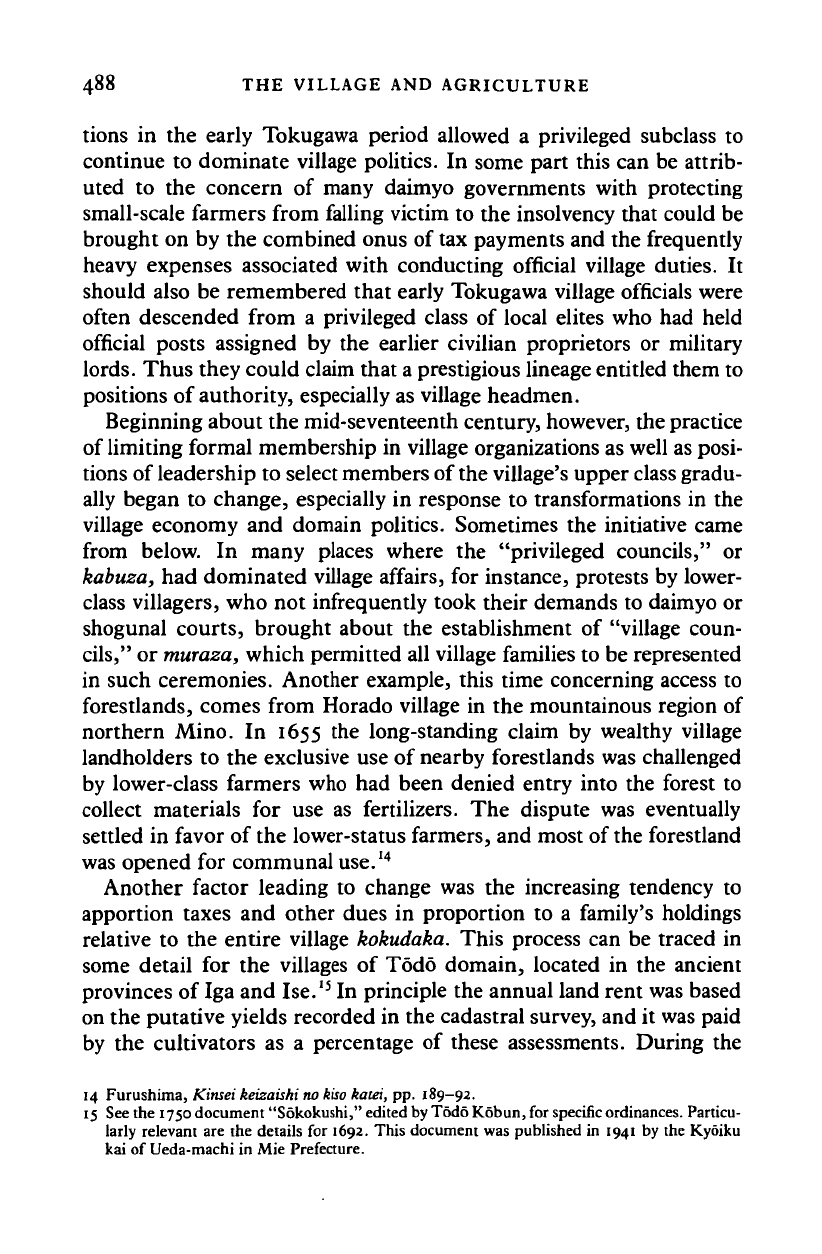
THE VILLAGE AND AGRICULTURE
tions in the early Tokugawa period allowed a privileged subclass to
continue to dominate village politics. In some part this can be attrib-
uted to the concern of many daimyo governments with protecting
small-scale farmers from falling victim to the insolvency that could be
brought on by the combined onus of tax payments and the frequently
heavy expenses associated with conducting official village duties. It
should also be remembered that early Tokugawa village officials were
often descended from a privileged class of local elites who had held
official posts assigned by the earlier civilian proprietors or military
lords.
Thus they could claim that a prestigious lineage entitled them to
positions of authority, especially as village headmen.
Beginning about the mid-seventeenth century, however, the practice
of limiting formal membership in village organizations as well as posi-
tions of leadership to select members of the village's upper class gradu-
ally began to change, especially in response to transformations in the
village economy and domain politics. Sometimes the initiative came
from below. In many places where the "privileged councils," or
kabuza, had dominated village affairs, for instance, protests by lower-
class villagers, who not infrequently took their demands to daimyo or
shogunal courts, brought about the establishment of "village coun-
cils,"
or
muraza,
which permitted all village families to be represented
in such ceremonies. Another example, this time concerning access to
forestlands, comes from Horado village in the mountainous region of
northern Mino. In 1655 the long-standing claim by wealthy village
landholders to the exclusive use of nearby forestlands was challenged
by lower-class farmers who had been denied entry into the forest to
collect materials for use as fertilizers. The dispute was eventually
settled in favor of the lower-status farmers, and most of
the
forestland
was opened for communal use.
14
Another factor leading to change was the increasing tendency to
apportion taxes and other dues in proportion to a family's holdings
relative to the entire village kokudaka. This process can be traced in
some detail for the villages of Todo domain, located in the ancient
provinces of Iga and Ise.'
5
In principle the annual land rent was based
on the putative yields recorded in the cadastral survey, and it was paid
by the cultivators as a percentage of these assessments. During the
14 Furushima, Kinsei keizaishi no
kiso
katei, pp. 189-92.
15 See the 1750 document "Sokokushi," edited by Todo Kobun, for specific ordinances. Particu-
larly relevant are the details for 1692. This document was published in 1941 by the Kyoiku
kai of Ueda-machi in Mie Prefecture.
Cambridge Histories Online © Cambridge University Press, 2008
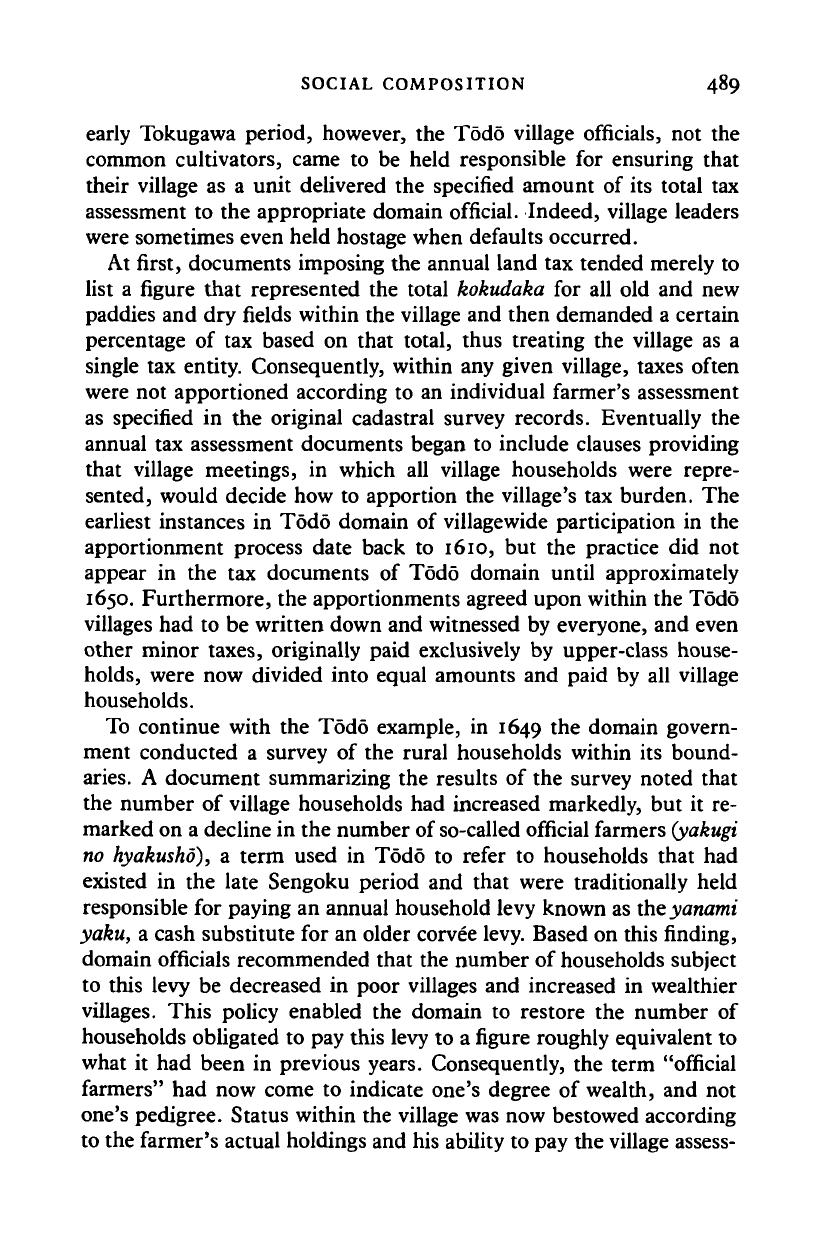
SOCIAL COMPOSITION 489
early Tokugawa period, however, the Todo village officials, not the
common cultivators, came to be held responsible for ensuring that
their village as a unit delivered the specified amount of its total tax
assessment to the appropriate domain official. Indeed, village leaders
were sometimes even held hostage when defaults occurred.
At first, documents imposing the annual land tax tended merely to
list a figure that represented the total kokudaka for all old and new
paddies and dry fields within the village and then demanded a certain
percentage of tax based on that total, thus treating the village as a
single tax entity. Consequently, within any given village, taxes often
were not apportioned according to an individual farmer's assessment
as specified in the original cadastral survey records. Eventually the
annual tax assessment documents began to include clauses providing
that village meetings, in which all village households were repre-
sented, would decide how to apportion the village's tax burden. The
earliest instances in Todo domain of villagewide participation in the
apportionment process date back to 1610, but the practice did not
appear in the tax documents of Todo domain until approximately
1650.
Furthermore, the apportionments agreed upon within the Todo
villages had to be written down and witnessed by everyone, and even
other minor taxes, originally paid exclusively by upper-class house-
holds,
were now divided into equal amounts and paid by all village
households.
To continue with the Todo example, in 1649 the domain govern-
ment conducted a survey of the rural households within its bound-
aries.
A document summarizing the results of the survey noted that
the number of village households had increased markedly, but it re-
marked on a decline in the number of so-called official farmers
(yakugi
no
hyakusho),
a term used in Todo to refer to households that had
existed in the late Sengoku period and that were traditionally held
responsible for paying an annual household levy known as the yanami
yaku, a cash substitute for an older corvee levy. Based on this finding,
domain officials recommended that the number of households subject
to this levy be decreased in poor villages and increased in wealthier
villages. This policy enabled the domain to restore the number of
households obligated to pay this levy to a figure roughly equivalent to
what it had been in previous years. Consequently, the term "official
farmers" had now come to indicate one's degree of wealth, and not
one's pedigree. Status within the village was now bestowed according
to the farmer's actual holdings and his ability to pay the village assess-
Cambridge Histories Online © Cambridge University Press, 2008
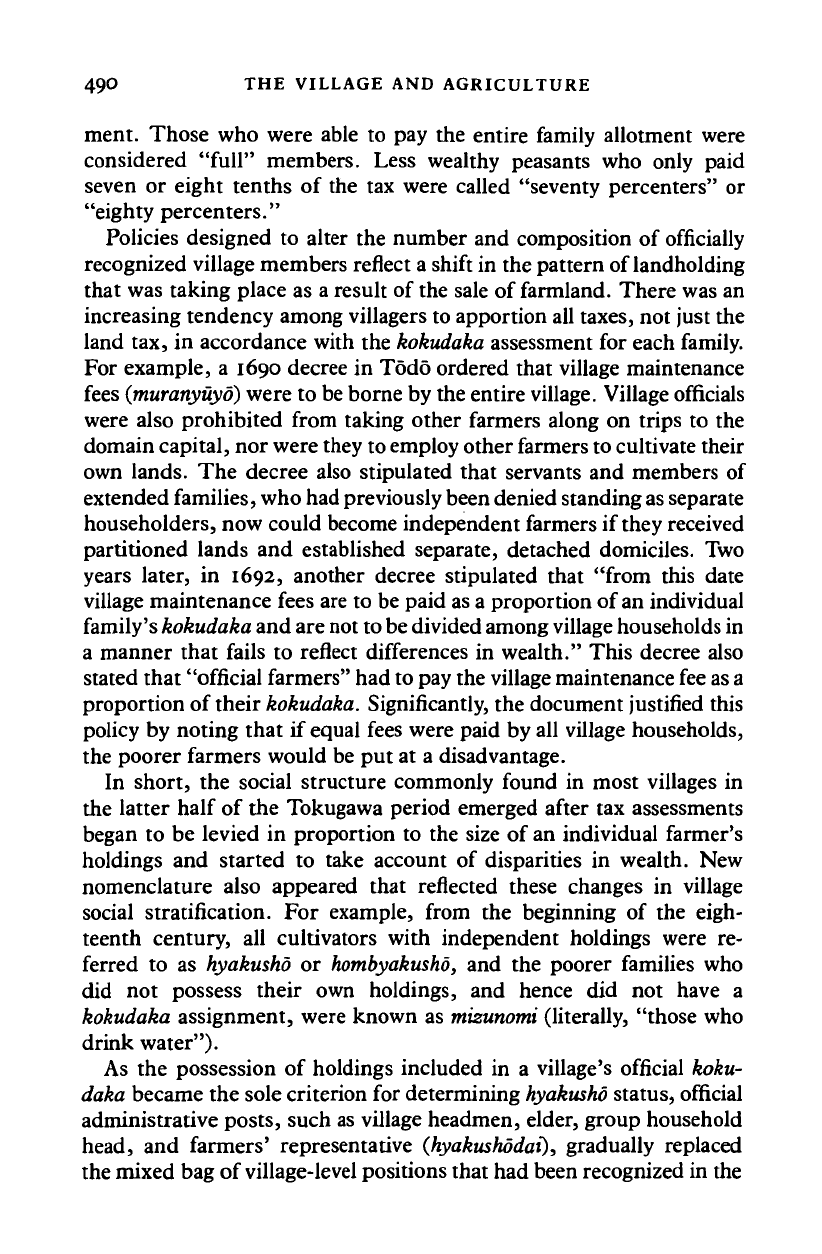
490 THE VILLAGE AND AGRICULTURE
ment. Those who were able to pay the entire family allotment were
considered "full" members. Less wealthy peasants who only paid
seven or eight tenths of the tax were called "seventy percenters" or
"eighty percenters."
Policies designed to alter the number and composition of officially
recognized village members reflect a shift in the pattern of landholding
that was taking place as a result of the sale of farmland. There was an
increasing tendency among villagers to apportion all taxes, not just the
land tax, in accordance with the
kokudaka
assessment for each family.
For example, a 1690 decree in Todo ordered that village maintenance
fees
(muranyuyo)
were to be borne by the entire
village.
Village officials
were also prohibited from taking other farmers along on trips to the
domain capital, nor were they to employ other farmers to cultivate their
own lands. The decree also stipulated that servants and members of
extended families, who had previously been denied standing
as
separate
householders, now could become independent farmers if they received
partitioned lands and established separate, detached domiciles. Two
years later, in 1692, another decree stipulated that "from this date
village maintenance fees are to be paid as a proportion of an individual
family's
kokudaka
and are not to
be
divided among
village
households in
a manner that fails to reflect differences in wealth." This decree also
stated that "official farmers" had to pay the village maintenance fee
as a
proportion of their
kokudaka.
Significantly, the document justified this
policy by noting that if equal fees were paid by all village households,
the poorer farmers would be put at a disadvantage.
In short, the social structure commonly found in most villages in
the latter half of the Tokugawa period emerged after tax assessments
began to be levied in proportion to the size of an individual farmer's
holdings and started to take account of disparities in wealth. New
nomenclature also appeared that reflected these changes in village
social stratification. For example, from the beginning of the eigh-
teenth century, all cultivators with independent holdings were re-
ferred to as hyakusho or
hombyakusho,
and the poorer families who
did not possess their own holdings, and hence did not have a
kokudaka assignment, were known as
mizunomi
(literally, "those who
drink water").
As the possession of holdings included in a village's official koku-
daka became the sole criterion for determining
hyakusho
status, official
administrative posts, such as village headmen, elder, group household
head, and farmers' representative
(hyakushodai),
gradually replaced
the mixed bag of village-level positions that had been recognized in the
Cambridge Histories Online © Cambridge University Press, 2008

SOCIAL COMPOSITION 491
early Tokugawa years.
16
Moreover, the method of selecting village
officials became more open. In the early years of the Tokugawa period,
village officials were usually appointed by the domain government,
and almost all were drawn from the same traditional upper-class fami-
lies,
often referred to as the
otona-byakusho,
or elder farmers, who had
dominated so many other aspects of village life. But as landholding
patterns and taxation methods changed, new people felt that they had
achieved a more equitable standing in the village, and so they began to
press for administrative changes that would give them a larger voice in
village political affairs.
In 1841, for example, a coalition of village officials and otona-
byakusho
of a village in Mino Province submitted a document to the
local lord that set out guidelines for resolving a dispute that had
erupted over nominating a man to serve as village headman.
17
These
guidelines established new rules to govern the election of future village
officials by providing that two members from a group of six former
elders
(toshiyori)
would serve alternately as headman for three years
while the other four continued to serve as elders. This measure essen-
tially created a six-member council to govern the village. Routine
village functions were to be carried out by the six elders in consulta-
tion. All "elder farmers" were allowed to participate in discussions of
special matters such as the apportionment of the annual land tax, the
official domain inspection of the rice crop, and the provision of lodg-
ing for visiting officials. Among the thirteen signatories of the docu-
ment, social distinctions remained. Only one wrote
hyakusho
under his
name. The remaining twelve listed themselves as
otona-byakusho,
one
of whom was a farmer's representative, and six of whom were elders.
The sharp social barriers between farmers who had the status neces-
sary to become village officials and the lower-class farmers began to
crumble even more after the 1720s when disturbances and even violent
demonstrations flared up concerning the election of ordinary peasants
as village officials, usually in regions where viable markets had devel-
oped for agricultural goods.
18
For instance, in 1642 the shogunate
16 For a discussion of village offices in English, see Harumi Befu, "Duty, Reward, Sanction and
Power: The Four Cornered Office of the Tokugawa Village Headman," in Bernard S.
Silberman and Harry D. Harootunian, eds., Modem Japanese
Leadership
(Tucson: University
of Arizona Press, 1966), pp. 25-50; and Harumi Befu, "Village Autonomy and Articulation
with the
State,"
in
John Whitney Hall
and
Marius B. Jansen,
eds.,
Studies in
the Institutional His-
tory
of Early Modem Japan (Princeton, N.J.: Princeton University Press, 1968), pp. 301-14.
17 Gifu
kenshi
shiryd,
vol. 4, doc. 133, pp. 594-6.
18 A detailed discussion of this process in Kurashiki can be found in Thomas C. Smith, The
Agrarian Origins of Modem Japan (Stanford,
Calif.:
Stanford University Press, 1959), pp.
180-200.
Cambridge Histories Online © Cambridge University Press, 2008
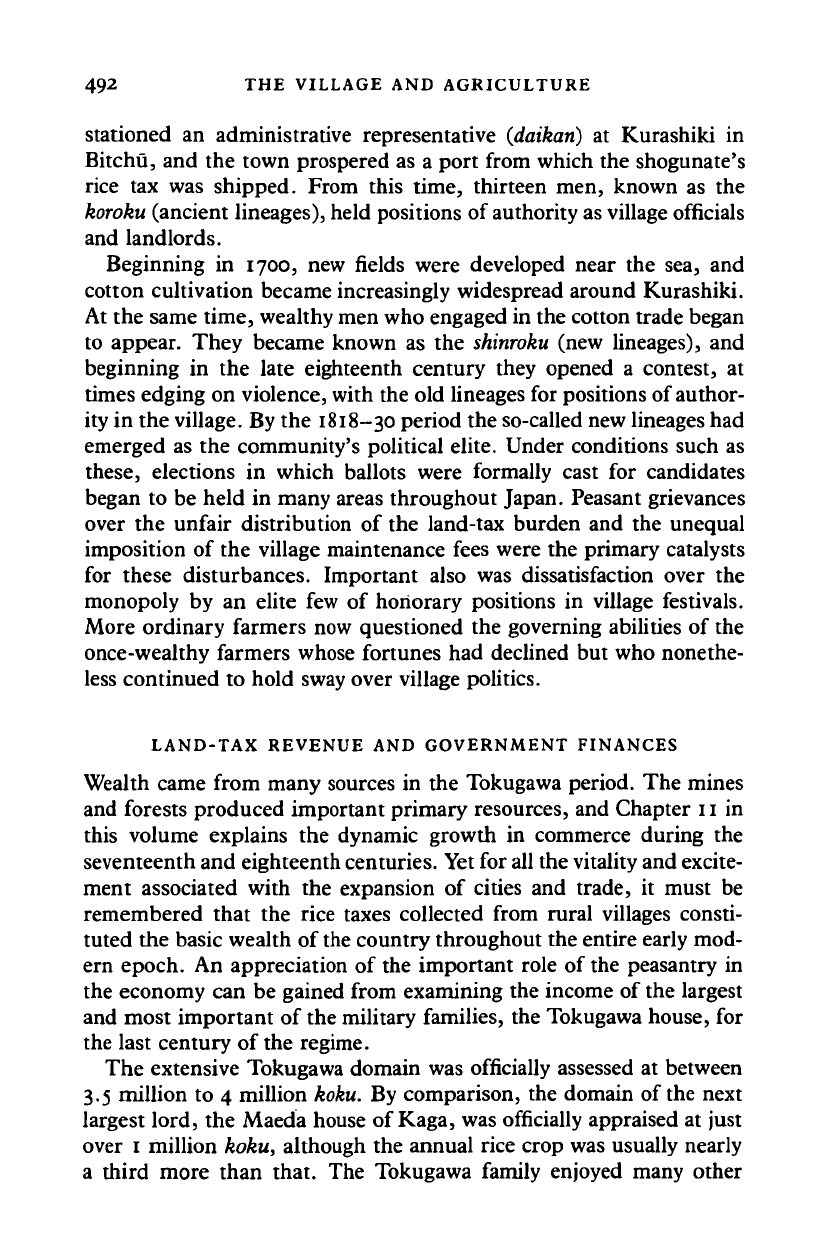
492 THE VILLAGE AND AGRICULTURE
stationed an administrative representative
(daikari)
at Kurashiki in
Bitchu, and the town prospered as a port from which the shogunate's
rice tax was shipped. From this time, thirteen men, known as the
koroku
(ancient lineages), held positions of authority as village officials
and landlords.
Beginning in 1700, new fields were developed near the sea, and
cotton cultivation became increasingly widespread around Kurashiki.
At the same time, wealthy men who engaged in the cotton trade began
to appear. They became known as the
shinroku
(new lineages), and
beginning in the late eighteenth century they opened a contest, at
times edging on violence, with the old lineages for positions of author-
ity in the village. By the 1818-30 period the so-called new lineages had
emerged as the community's political elite. Under conditions such as
these, elections in which ballots were formally cast for candidates
began to be held in many areas throughout Japan. Peasant grievances
over the unfair distribution of the land-tax burden and the unequal
imposition of the village maintenance fees were the primary catalysts
for these disturbances. Important also was dissatisfaction over the
monopoly by an elite few of honorary positions in village festivals.
More ordinary farmers now questioned the governing abilities of the
once-wealthy farmers whose fortunes had declined but who nonethe-
less continued to hold sway over village politics.
LAND-TAX REVENUE AND GOVERNMENT FINANCES
Wealth came from many sources in the Tokugawa period. The mines
and forests produced important primary resources, and Chapter
11
in
this volume explains the dynamic growth in commerce during the
seventeenth and eighteenth centuries. Yet for all the vitality and excite-
ment associated with the expansion of cities and trade, it must be
remembered that the rice taxes collected from rural villages consti-
tuted the basic wealth of
the
country throughout the entire early mod-
ern epoch. An appreciation of the important role of the peasantry in
the economy can be gained from examining the income of the largest
and most important of the military families, the Tokugawa house, for
the last century of the regime.
The extensive Tokugawa domain was officially assessed at between
3.5 million to 4 million
koku.
By comparison, the domain of the next
largest lord, the Maeda house of Kaga, was officially appraised at just
over 1 million koku, although the annual rice crop was usually nearly
a third more than that. The Tokugawa family enjoyed many other
Cambridge Histories Online © Cambridge University Press, 2008
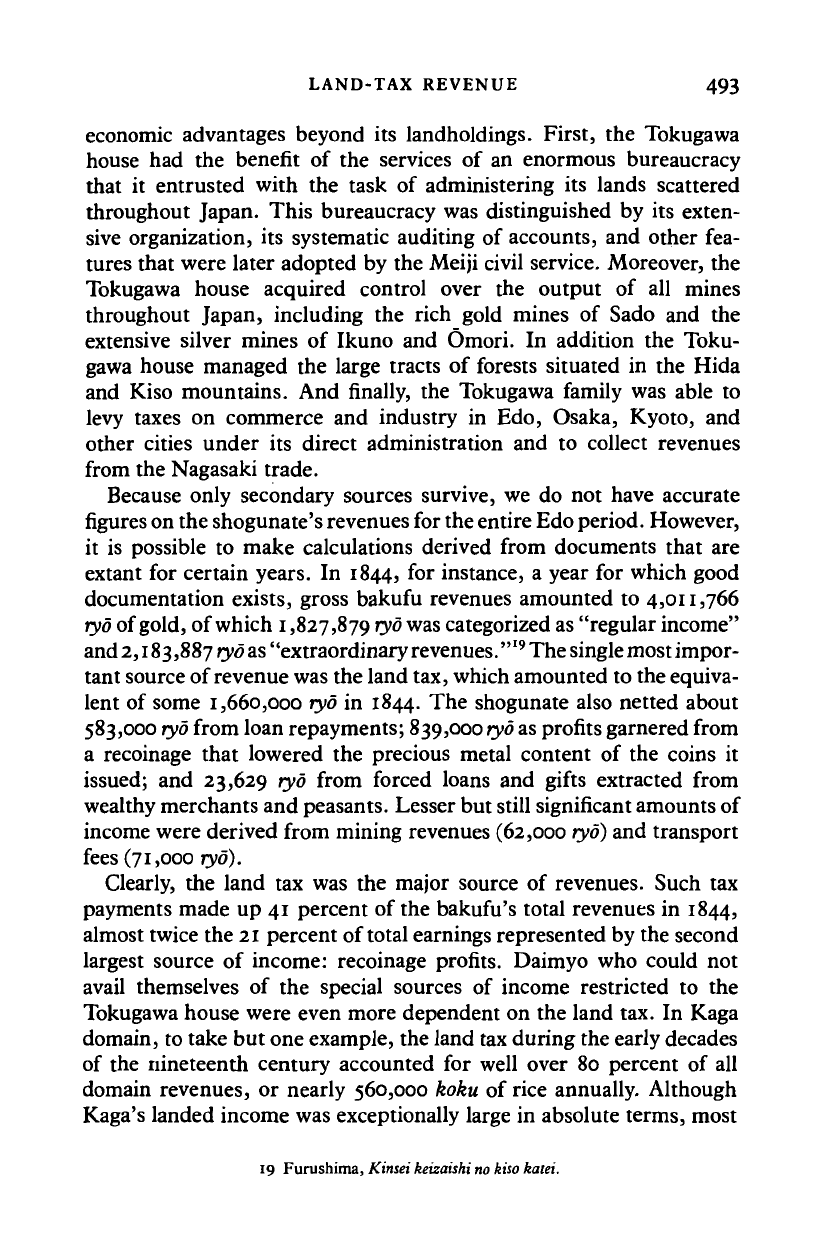
LAND-TAX REVENUE 493
economic advantages beyond its landholdings. First, the Tokugawa
house had the benefit of the services of an enormous bureaucracy
that it entrusted with the task of administering its lands scattered
throughout Japan. This bureaucracy was distinguished by its exten-
sive organization, its systematic auditing of accounts, and other fea-
tures that were later adopted by the Meiji civil service. Moreover, the
Tokugawa house acquired control over the output of all mines
throughout Japan, including the rich gold mines of Sado and the
extensive silver mines of Ikuno and Omori. In addition the Toku-
gawa house managed the large tracts of forests situated in the Hida
and Kiso mountains. And finally, the Tokugawa family was able to
levy taxes on commerce and industry in Edo, Osaka, Kyoto, and
other cities under its direct administration and to collect revenues
from the Nagasaki trade.
Because only secondary sources survive, we do not have accurate
figures on the shogunate's revenues for the entire
Edo
period.
However,
it is possible to make calculations derived from documents that are
extant for certain years. In 1844, for instance, a year for which good
documentation exists, gross bakufu revenues amounted to 4,011,766
ryo
of gold, of which
1,827,879
ryo was
categorized as "regular income"
and 2,183,887 ryo
as
"extraordinary revenues."
19
The single most impor-
tant source of revenue was the land tax, which amounted to the equiva-
lent of some
1,660,000
ryo
in 1844. The shogunate also netted about
583,000
ryo
from loan repayments; 839,000
ryo as
profits garnered from
a recoinage that lowered the precious metal content of the coins it
issued; and 23,629 ryo from forced loans and gifts extracted from
wealthy merchants and peasants. Lesser but still significant amounts of
income were derived from mining revenues (62,000
ryo)
and transport
fees (71,000 ryo).
Clearly, the land tax was the major source of revenues. Such tax
payments made up 41 percent of the bakufu's total revenues in 1844,
almost twice the
21
percent of total earnings represented by the second
largest source of income: recoinage profits. Daimyo who could not
avail themselves of the special sources of income restricted to the
Tokugawa house were even more dependent on the land tax. In Kaga
domain, to take but one example, the land tax during the early decades
of the nineteenth century accounted for well over 80 percent of all
domain revenues, or nearly 560,000 koku of rice annually. Although
Kaga's landed income was exceptionally large in absolute terms, most
19 Furushima, Kinsei keizaishi
no
kiso kalei.
Cambridge Histories Online © Cambridge University Press, 2008
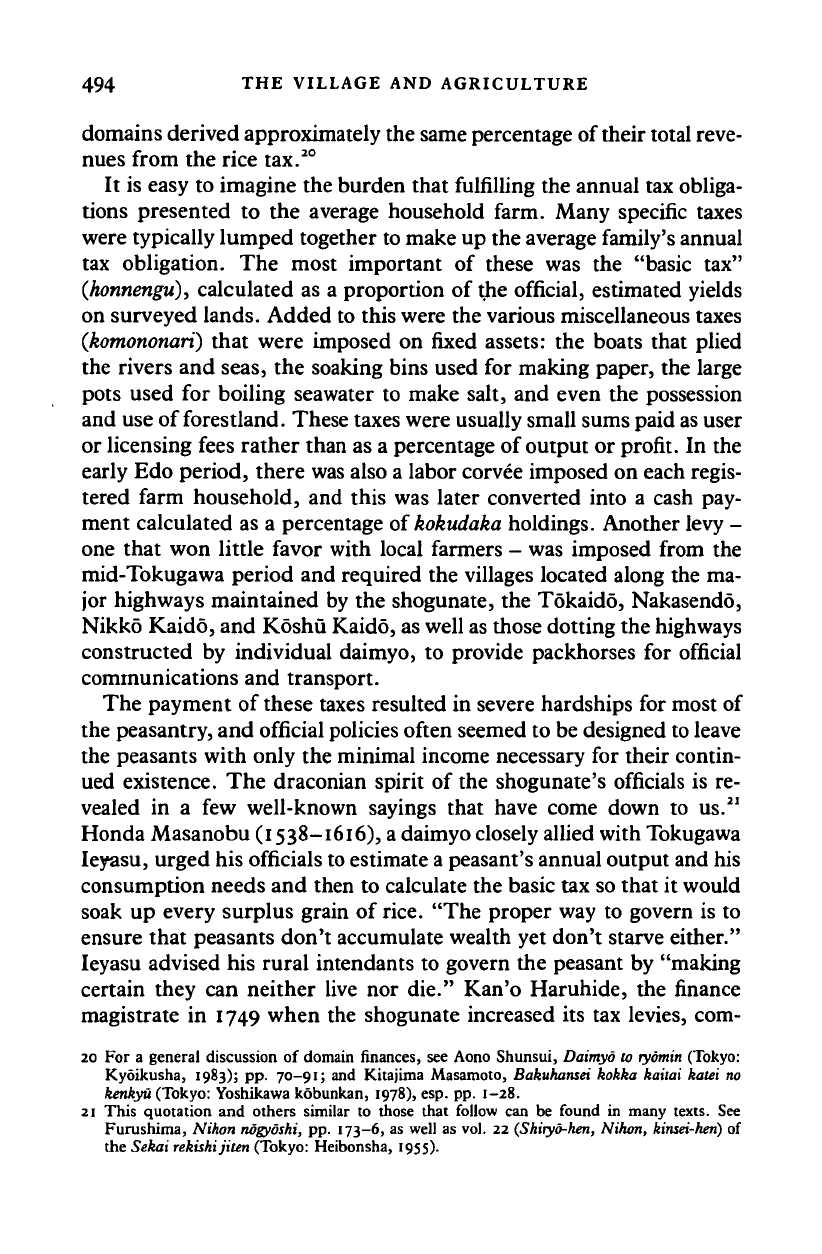
494 THE VILLAGE AND AGRICULTURE
domains derived approximately the same percentage of their total reve-
nues from the rice tax.
20
It is easy to imagine the burden that fulfilling the annual tax obliga-
tions presented to the average household farm. Many specific taxes
were typically lumped together to make up the average family's annual
tax obligation. The most important of these was the "basic tax"
(honnengu),
calculated as a proportion of the official, estimated yields
on surveyed lands. Added to this were the various miscellaneous taxes
(komononari)
that were imposed on fixed assets: the boats that plied
the rivers and seas, the soaking bins used for making paper, the large
pots used for boiling seawater to make salt, and even the possession
and use of forestland. These taxes were usually small sums paid as user
or licensing fees rather than as a percentage of output or profit. In the
early Edo period, there was also a labor corvee imposed on each regis-
tered farm household, and this was later converted into a cash pay-
ment calculated as a percentage of
kokudaka
holdings. Another levy -
one that won little favor with local farmers - was imposed from the
mid-Tokugawa period and required the villages located along the ma-
jor highways maintained by the shogunate, the Tokaido, Nakasendo,
Nikko Kaido, and Koshu Kaido, as well as those dotting the highways
constructed by individual daimyo, to provide packhorses for official
communications and transport.
The payment of these taxes resulted in severe hardships for most of
the peasantry, and official policies often seemed to be designed to leave
the peasants with only the minimal income necessary for their contin-
ued existence. The draconian spirit of the shogunate's officials is re-
vealed in a few well-known sayings that have come down to us.
21
Honda Masanobu (1538-1616), a daimyo closely allied with Tokugawa
Ieyasu, urged his officials to estimate
a
peasant's annual output and his
consumption needs and then to calculate the basic tax so that it would
soak up every surplus grain of rice. "The proper way to govern is to
ensure that peasants don't accumulate wealth yet don't starve either."
Ieyasu advised his rural intendants to govern the peasant by "making
certain they can neither live nor die." Kan'o Haruhide, the finance
magistrate in 1749 when the shogunate increased its tax levies, com-
20 For a general discussion of domain finances, see Aono Shunsui, Daimyo to
ryomin
(Tokyo:
Kyoikusha, 1983); pp.
70-91;
and Kitajima Masamoto, Bakuhansei kokka kailai katei no
kenkyu (Tokyo: Yoshikawa kobunkan, 1978), esp. pp. 1-28.
21 This quotation and others similar to those that follow can be found in many texts. See
Furushima, Nihon nogydshi, pp. 173—6, as well as vol. 22 (Shiryo-hen, Nihon,
kinsei-hen)
of
the Sekai rekishijiten (Tokyo: Heibonsha, 1955).
Cambridge Histories Online © Cambridge University Press, 2008
